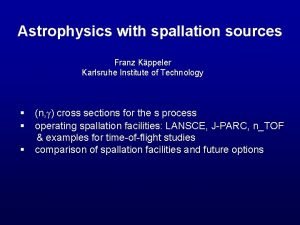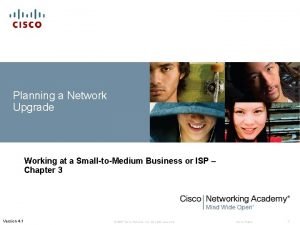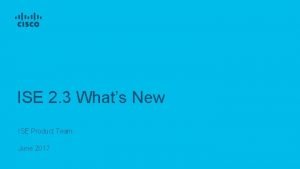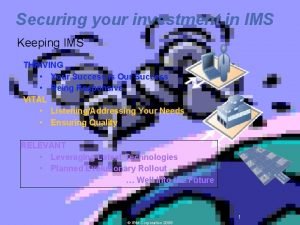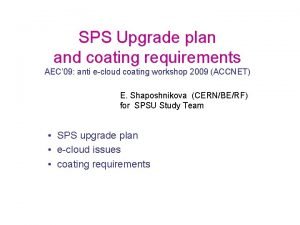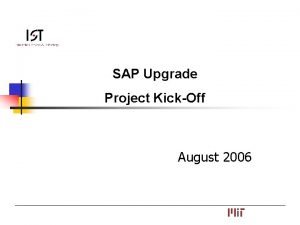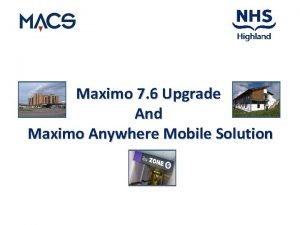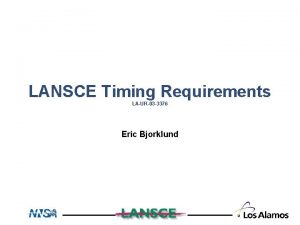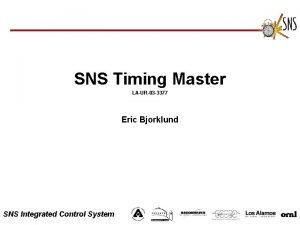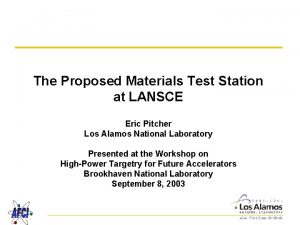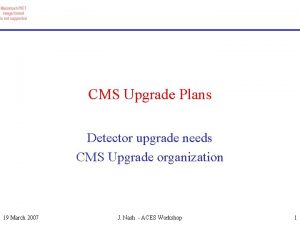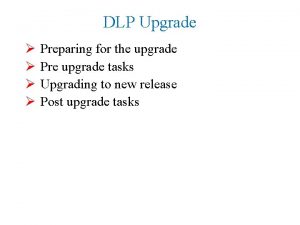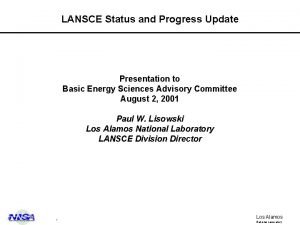Status of the LANSCE Upgrade LAUR03 3378 Eric










- Slides: 10

Status of the LANSCE Upgrade LA-UR-03 -3378 Eric Bjorklund

History • LANSCE began life in 1972 as “LAMPF” an 800 Me. V proton accelerator for studying mesons. • Storage ring added in 1985. • Principle focus changed from mesons to neutrons in 1997. • First control system upgrade (1979 -1988) – Change from centralized system based on SEL-840 (DTL-logic) computer to distributed VAX-based system. • Second control system upgrade (1994 -200? ) – Started with conversion of storage ring controls to EPICS

Present Status • All the easy parts have been done. – – – 17 IOCs 10, 069 PV’s (6, 447 hardware channels) 484 dm screens 101 tcl/tk screens 13 java app’s • Remaining “hard” parts – Diagnostics • Harps • Wire Scanners • Emittance – Timing – RICE

What Is RICE, And Why Is It Hard? • RICE = Remote Instrumentation & Control Equipment – The original data acquisition front-end for LAMPF. • Approximately 10, 200 channels are still connected. – (about 60% of the total hardware channels)

RICE Features Typical RICE Module • Analog Input – 12 Bit ADC – ~64 channels/module • Analog Output – Stepper-motor controlled pots – ~25 channels/module • Binary Input – ~144 channels/module (12 words) • Binary Output – ~48 channels/module (4 words) – Latched to readback channels • Fast Protect Status – 12 channels/module (Binary Word 8)

RICE Architecture • Star configuration – – • • Serial communication lines from RICE Interface Unit (RIU) to RICE modules. RIU issues parallel read requests. – – – • Timing Signals • “Timed Data” Read requests can be queued for machine cycles with specific beam gate configurations. – Ethernet Provides transverse snapshot of accelerator. “Vector Data” Fast Protect status read this way Read requests can be delayed relative to the start of the machine cycle. – RIU Up to 127 modules. 72 modules currently in use. “Flavored Data”

RICE Special Features • Timed Data – Any channel can be sampled at any time in the machine cycle – Poor-Man’s “Scope Trace” by sampling the signal over several cycles at successive time increments. – “Non-RF” tag allows us to sample outside the RF gates. • (eliminates RF noise on signals that are supposed to be stable) • Flavored Data – Any channel can be sampled on a cycle with any arbitrary combination (present/absent/don’t care) of beam gates. – 396 (~6 x 1045) possible “flavors”. – Not all of these flavors are useful. • Vector Data – Transverse snapshot of all the data on a particular channel. – Fast Protect trips reported this way. • Any combination of the above

The “Easy” Part of RICE • About 9, 000 of the existing RICE channels (88%) don’t require any of the RICE special features (timed / flavored / vectored) – May still need to worry about “Non-RF” • Plan in progress to replace binary input, binary output, analog output, and “easy” analog input channels with Allen-Bradley Control-Logix PLCs. – – • Binary Input: Binary Output: Analog Input: Analog Output: 1756 -IB 32 1756 -OW 16 I/A 1756 -SC-IF 8 U AMCI-3202/AMCI-3204 (stepper motor controller) Proof-of-Principle experiment during 2002 run cycle. – All binary I/O from one RICE module (except Fast-Protect) replaced with Allen-Bradley. • M. Oothoudt, et al. , “The LANSCE RICE Control System Upgrade”, (LA-UR-03 -2758) Proceedings 20 th Particle Accelerator Conference, May 2003, Portland OR, USA

The “Easy” Part of the “Hard” Part of RICE • • • Fast-Protect being broken out into a separate system. Most of the “Timed” channels only use a single (default) time and flavor. An intelligent, 14 -bit, 8 channel, 10 MHz, VME waveform digitizer board is being developed for a new Low-Momentum Detector application. – • Rob Merl, et al. , “A Multiwire Proportional Chamber System for Monitoring Low Momentum Beam In Accelerators”, (LA-UR-03 -2923) Proceedings 20 th Particle Accelerator Conference, May 2003, Portland OR, USA Idea is that this board can be adapted to handle timed data, either by external trigger, or picking the desired data point out of the waveform. – Rob Merl, et al. , “High Speed EPICS Data Acquisition and Processing on One VME Board”, (LA-UR-03 -2925) Proceedings 20 th Particle Accelerator Conference, May 2003, Portland OR, USA

The Hard Part of the Hard Part of RICE • Flavored Data: – May need special record support. • Vector Data: – Do we need time-correlated data from PLCs? • General Timed/Flavored Data Problem: – Each application wants to pick its own time and flavor. – Change time/flavor spec on a per-read basis. – No vocabulary for this in channel access.
